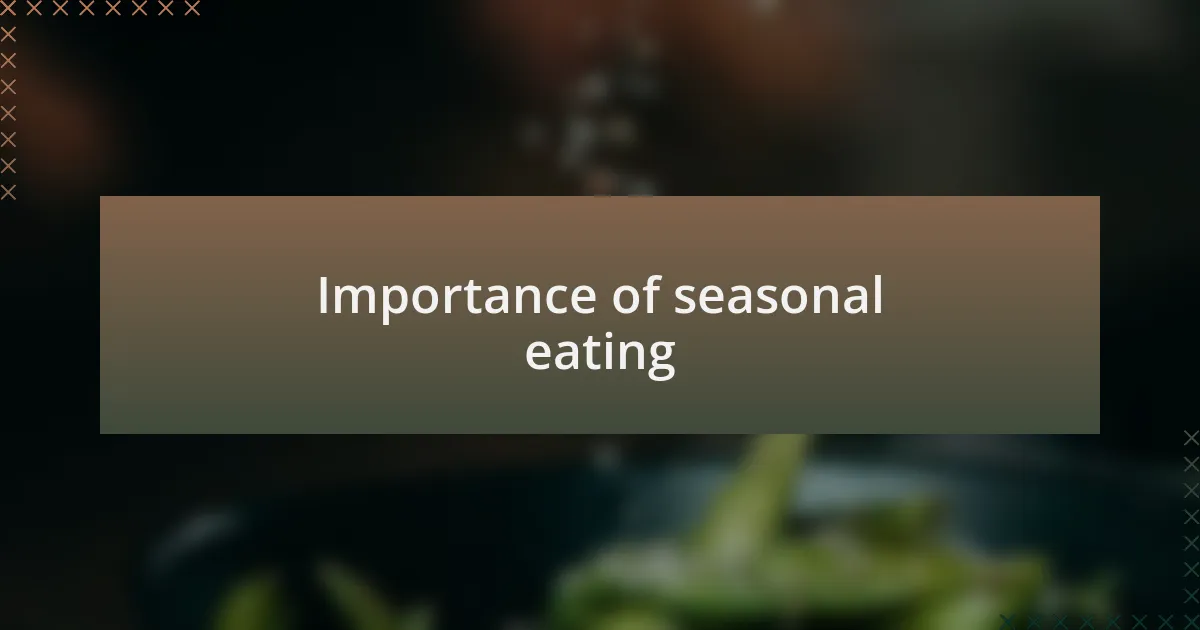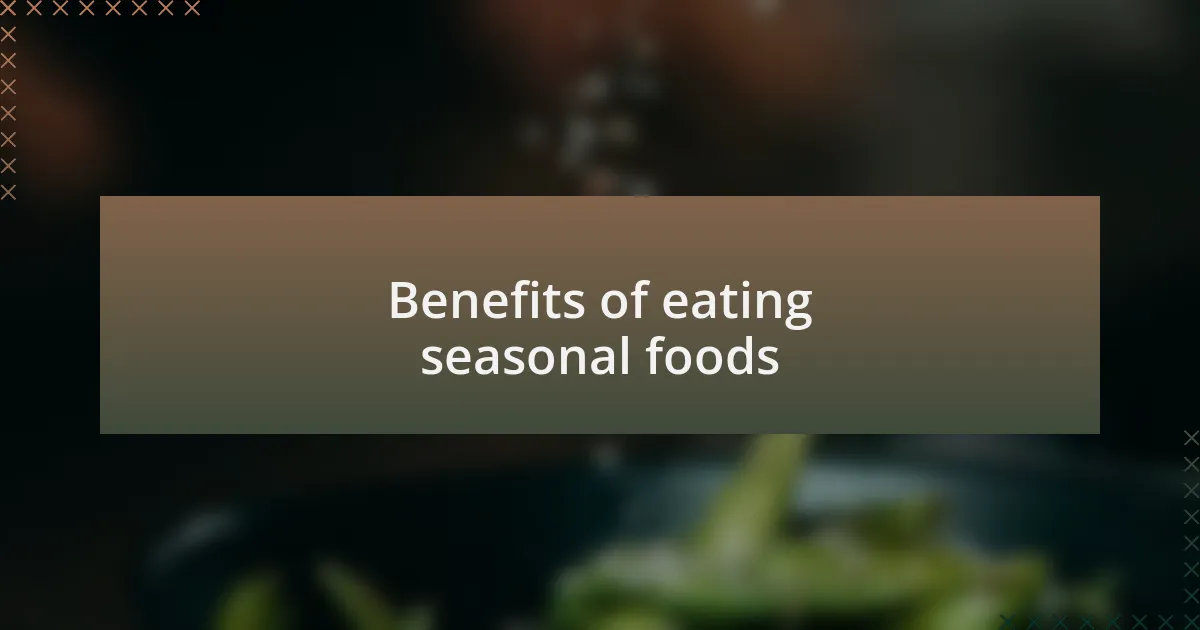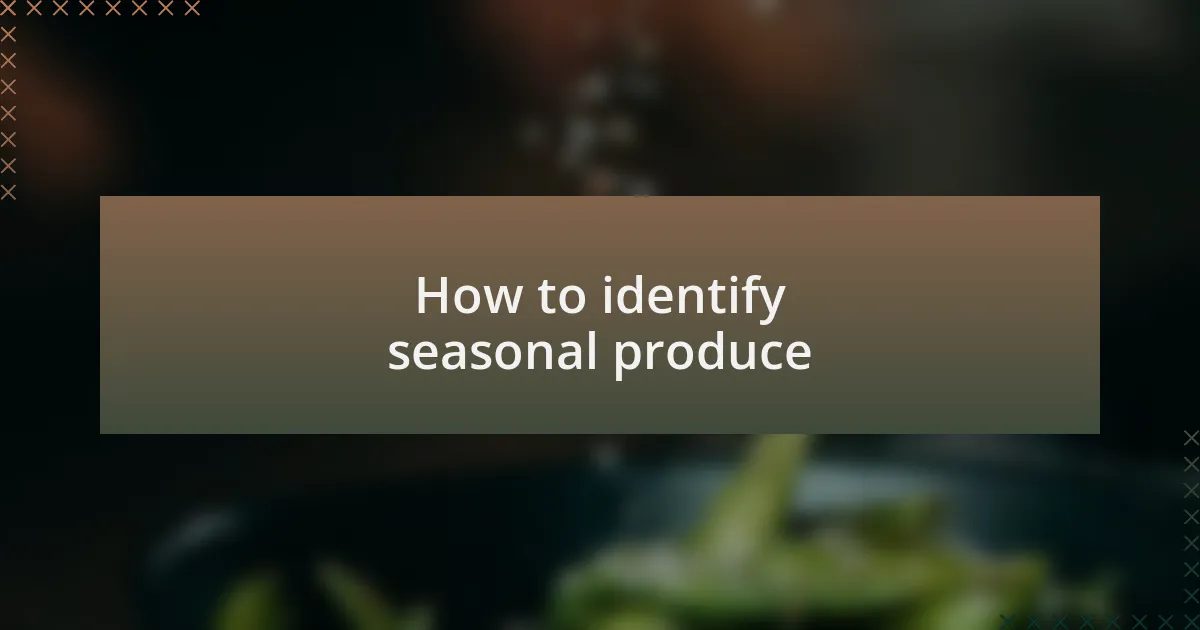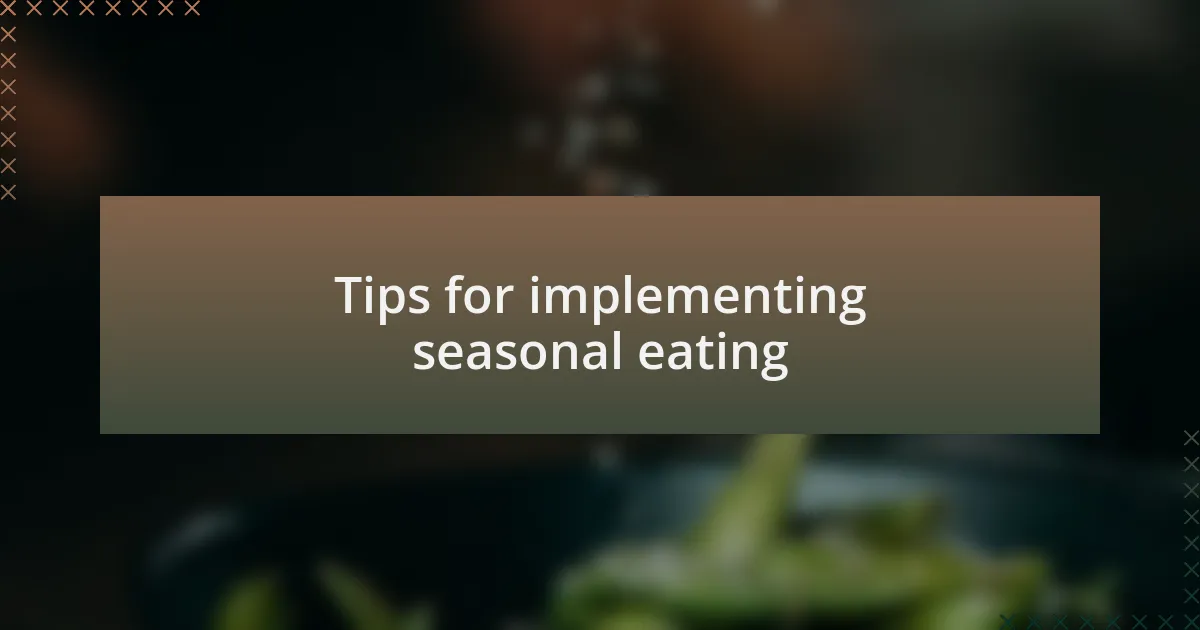Key takeaways:
- Healthy eating is about mindfulness and balance, focusing on whole foods and listening to body signals.
- Eating seasonally enhances flavor, nutrition, and sustainability, while promoting a connection to local food sources.
- Planning meals around seasonal ingredients fosters creativity, variety, and a deeper appreciation for nature’s rhythms.
- Implementing seasonal eating can be achieved by visiting farmers’ markets, meal planning based on local availability, and preserving seasonal produce.

Healthy eating explained
Healthy eating is not just a list of foods to avoid or consume; it’s more like an art form that requires understanding and practice. When I transitioned to a healthier lifestyle, I realized that every meal could be an opportunity to nourish my body and uplift my mood. Have you ever noticed how fresh, seasonal fruits can turn an ordinary day into something special?
For me, healthy eating is deeply intertwined with mindfulness. It’s about being aware of what you put into your body and how it affects you. I still remember the first time I savored a home-cooked meal made from locally-sourced vegetables; it was a revelation! The taste was vibrant, and I felt an incredible connection to where my food came from. What if we all took a moment to appreciate the natural flavors and nutrients in our meals?
Ultimately, healthy eating is about balance. While it’s easy to get caught up in dietary trends, I find that listening to my body’s needs leads to the best choices. Are you tuned into your own body signals? Embracing whole foods and seasonal ingredients has taught me to trust myself in the kitchen, and it can do the same for you.

Importance of seasonal eating
Embracing seasonal eating has taught me the true importance of freshness. I still recall visiting a local farmer’s market in autumn, surrounded by vibrant pumpkins and crisp apples. Each bite felt like a celebration of the season, highlighting how ingredients at their peak ripeness provide not only exceptional taste but also higher nutrient levels.
Seasonal eating isn’t just about flavor; it also promotes sustainability. I remember my own surprise when I learned that choosing local, in-season produce can significantly reduce my carbon footprint. When I buy zucchini in July rather than January, I’m not only supporting local farmers but also helping the environment. How often do we consider the hidden costs of off-season foods?
Furthermore, there’s something incredibly comforting about eating with the rhythm of nature. I often find that my cravings align with what’s in season—spicy soups in winter or refreshing salads in summer. This connection makes meal planning feel more intuitive and enjoyable. Have you ever noticed how certain foods just feel right during specific times of the year? That’s the beauty of listening to nature’s cues.

Benefits of eating seasonal foods
Eating seasonal foods provides a wealth of health benefits. When I first switched to a seasonal diet, I noticed a remarkable change in my energy levels. This occurred in late spring when I began incorporating fresh strawberries and asparagus into my meals. These vibrant foods not only tasted better than their out-of-season counterparts, but they also packed a nutritional punch. The vitamins and minerals in seasonal produce seem to shine through, offering a refreshing boost that I can’t help but appreciate.
Another advantage of seasonal eating is its ability to encourage variety in our diets. As I moved through different seasons, I realized I was incorporating a wider range of fruits and vegetables than ever before. Suddenly, my plate wasn’t always filled with the same old choices—each season brought new flavors and textures to explore. Have you ever felt that excitement when you first spot fresh, locally grown tomatoes at the market? That thrill not only inspires creativity in the kitchen but also keeps my diet balanced and nourishing.
Moreover, there’s a profound sense of community that comes from sourcing seasonal foods. I vividly recall a summer evening spent at a local farm, picking ripe peaches straight from the tree with friends. That experience connected me to my food in a way I had never felt before. Engaging with local farmers and learning about their practices foster a sense of gratitude and responsibility towards our food system. Isn’t it empowering to know that our choices support the people who cultivate our sustenance?

How to identify seasonal produce
Identifying seasonal produce can feel like a delightful treasure hunt, especially at local farmers’ markets. I remember the thrill of walking through rows of colorful stalls, each one bursting with ripeness that mirrored the season. Ask yourself, are the fruits and vegetables vibrant and at their peak? When strawberries are plump and sweet in June or pumpkins robust in October, it’s a sure sign they’re in season.
Another tip I’ve found helpful is to familiarize myself with what grows when in my region. Since moving to the countryside, I’ve kept a seasonal calendar that highlights what I should expect throughout the year. It’s like unlocking a secret code that reveals bursts of flavor waiting to be discovered. Ever tried fresh corn straight from the cob in late summer? It’s an experience unlike any other.
I also rely on the sense of community that surrounds seasonal eating. Conversations with local farmers have opened my eyes to the best times to buy certain produce. At a recent visit to my local farm, I chatted with a farmer about heirloom tomatoes, and he eagerly pointed out the varieties that would soon be ready for harvest. That personal connection not only helps me identify seasonal produce but also makes each bite feel like a celebration of our shared environment. How can you resist the urge to bite into something that’s truly fresh and newly harvested?

Planning meals around seasons
Planning meals around the seasons can transform how we experience food. For me, autumn’s arrival means whipping up hearty soups filled with tender squash and earthy root vegetables. I still recall the first time I made a butternut squash soup; the aroma wafting through my kitchen was pure comfort, and it turned an ordinary evening into something special. Isn’t it amazing how the right ingredients can set the mood for the entire meal?
I’ve learned that adapting recipes to fit seasonal ingredients can be both creative and fulfilling. When spring rolls around, I dive into lighter dishes, often experimenting with vibrant salads incorporating fresh greens and peas. One spring afternoon, I had a spontaneous picnic with friends, tossing together a salad that celebrated the season. It was refreshing, and sharing that meal outdoors felt like a celebration of life itself. Don’t you think food tastes better when it echoes the energy of the season?
Meal planning also involves being mindful of what’s available at the peak of its season. I’ve found that shopping from my local farmers’ market isn’t just about the food; it’s about rediscovering the joy of cooking with fresh, high-quality ingredients. I often leave with baskets brimming with ripe tomatoes and fragrant herbs, the kind that inspire new recipes. By aligning my meals with the changing seasons, I embrace a culinary rhythm that makes each phase of the year feel distinct and rewarding. How do you feel when you cook with what’s currently in season?

My personal seasonal eating philosophy
My personal approach to seasonal eating is rooted in a deep appreciation for nature’s rhythm. For instance, summer always brings back memories of sun-kissed gatherings where I create dishes bursting with juicy peaches and sweet corn. I remember savoring a ripe peach straight from the tree during a family trip, and the explosion of flavor reminded me how profoundly food can connect us to our surroundings.
I believe there’s a certain magic that comes with cooking seasonally. Just recently, I found myself in a winter evening, warming up with a simple, rustic vegetable stew. It was comforting not only because of the flavors but also because each ingredient—carrots, potatoes, and cabbage—carried the essence of the season. Is there a more satisfying feeling than nurturing your body with foods that come naturally at that time of year?
This connection to seasonal produce also encourages me to be more adventurous in my cooking. For instance, in the depths of winter, I experiment with spices I often overlook in warmer months. I vividly recall a golden turmeric and ginger-infused dish that not only warmed me up but invigorated my spirit. How do you think such seasonal adaptations can elevate our culinary experiences?

Tips for implementing seasonal eating
One effective tip for implementing seasonal eating is to visit local farmers’ markets regularly. I remember my first visit; it felt like stepping into a treasure trove of vibrant produce that was both inviting and inspiring. Engaging with the farmers and learning about what’s in season not only enriches my understanding but often sparks new meal ideas that I wouldn’t have imagined otherwise. Have you ever experienced the joy of chatting with a farmer about their latest harvest?
Another approach is to plan your meals around what’s available in your area. For instance, during autumn, I make it a point to incorporate butternut squash and kale into my recipes. This simple shift not only ensures that I’m eating foods at their peak flavor but also aligns my meals with the changing seasons. It’s fascinating how the act of aligning my menu with seasonal produce transforms the dining experience into a celebration of what nature offers at that moment. How does it feel to eat foods that are truly in sync with your environment?
Lastly, consider preserving seasonal produce for later use. I often find myself making jars of pickles or fruit preserves in the summer when everything is ripe. There’s something incredibly satisfying about savoring that summer sweetness in the dead of winter, reminding me of sunny days even when it’s cold outside. Have you tried preserving a seasonal favorite? It adds a personal touch to your kitchen that makes cooking feel special year-round.